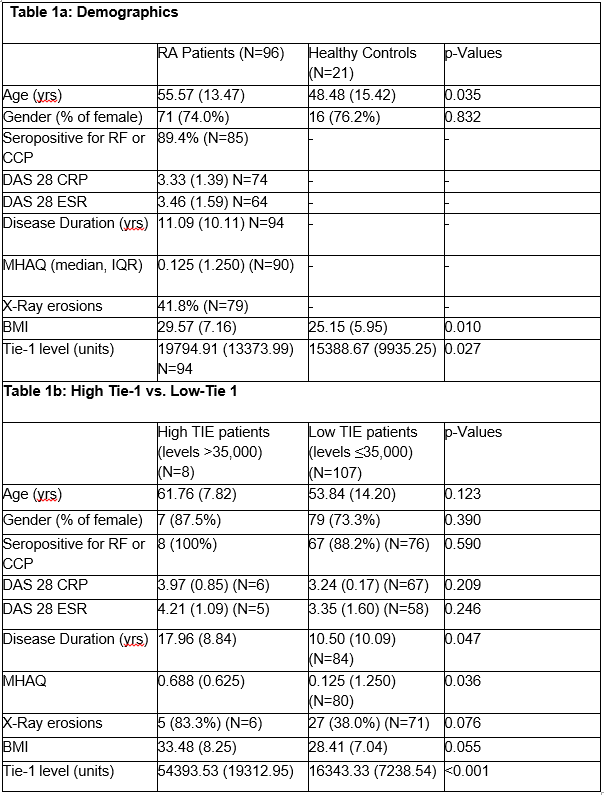Session Information
Session Type: Poster Session (Tuesday)
Session Time: 9:00AM-11:00AM
Background/Purpose: Rheumatoid arthritis (RA) is an autoimmune disease that primarily affects patients’ peripheral joints and can lead to severe personal disability from progressive articular joint destruction. The cause of RA is unknown. Recent studies have shown that collagen formation as well as angiogenesis are important in the pathophysiology of this disease. Specifically, serum vascular endothelial factor (VEGF) levels have been shown to be elevated in patients with RA and were correlated with the degree of radiographic joint damage. In addition to VEGF, a related angiogenic factor Tie-1 has been found to be elevated in RA synovial fluid. The objective of this study was to determine serum levels of Tie-1 in patients with RA and investigate associations with RA disease activity and RA clinical features.
Methods: 94 patients with RA and 21 healthy controls from the Penn State Hershey Investigation of Remission in Rheumatoid Arthritis (IRRA) cohort at Pennsylvania State M.S. Hershey Medical Center had measurement of serum Tie-1 levels using ELISA. High levels of Tie-1 were considered to be greater than 35,000. Mean Tie-1 levels were compared by T-test. Further analysis was performed using other available data including DAS 28 ESR/CRP, age, disease duration and mHAQ using Pearson’s correlation and linear regression. Further chart review analysis was done to correlate radiographic findings. Data are expressed as mean (standard deviation).
Results: The 94 subjects with RA had significantly higher serum Tie-1 levels compared to the healthy controls (19,794.91 (13,373.99) vs. 15,388.67 (9,935.25), p=0.027, Table 1a). There was a mild association between Tie-1 and DAS28ESR (β estimate 0.072; p=0.069). Eight subjects had high levels of Tie-1; 6 of these 8 patients had erosions on their x-rays (Table 1b). Patients with erosions had higher Tie-1 levels, but this was not statistically significant (P=0.125).
Conclusion: RA patients have higher levels of Tie-1 compared to healthy controls (Figure 1). High Tie-1 levels had a mild correlation with RA disease activity in this cross-sectional analysis. The etiology for the reason for higher levels of this angiogenesis factor in RA is unknown but may be related to synovial proliferation and other features of uncontrolled disease. Further research is needed to investigate the mechanism and source of the increase in serum and synovial fluid levels of TIE-1 and study as a biomarker of disease will be also of interest. These findings, combined with the previously described correlation between VEGF and RA activity, support the need to further understand the role of angiogenesis in the pathogenesis of RA.
To cite this abstract in AMA style:
Lee D, Mohan C, Feger D, Olsen N, June R. Elevated Serum Levels of Tie-1 in Patients with Rheumatoid Arthritis [abstract]. Arthritis Rheumatol. 2019; 71 (suppl 10). https://acrabstracts.org/abstract/elevated-serum-levels-of-tie-1-in-patients-with-rheumatoid-arthritis/. Accessed .« Back to 2019 ACR/ARP Annual Meeting
ACR Meeting Abstracts - https://acrabstracts.org/abstract/elevated-serum-levels-of-tie-1-in-patients-with-rheumatoid-arthritis/


